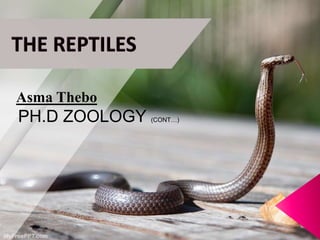
The reptiles
- 1. Asma Thebo PH.D ZOOLOGY (CONT…)
- 2. • Cold-Blooded • Regulate their body temperature using the environment • Can survive both on land and in water • Most lay eggs • Most have scales, none have hair or fur • All lack external ears. Four main groups of reptiles • Crocodiles • Lizards • Turtles • Snakes Asma Thebo (Department of STE) Asma Thebo (Department of STE)
- 3. EVOLUTIONARY PERSPECTIVE (reptos, to creep) Reptiles were the first vertebrates that possess amniotic eggs. Amniotic eggs have extra embroynic membranes. These membranes performs the following functions: 1. They Protect the embryo from dessication. 2. These support the embryo like cushion. 3. These membranes promote gas transfer. 4. These membranes remove the waste materials. Asma Thebo (Department of STE) Asma Thebo (Department of STE)
- 4. The amnioitic eggs of reptiles and birds also have following parts: 1. Shells: Birds and reptiles have hard or leathery shell. This shell protects the developing embryo. 2. Albumin: The albumen cushions the embryo. It also provides moisture and nutrients to the embno. 3. Yolk: The yolk supplies food to the embryo. Asma Thebo (Department of STE) Asma Thebo (Department of STE)
- 5. All these features are adaptations for development on land. The amniotic egg is the major synapomorphy (distinguishing characteristic). It distinguishes the reptiles, birds, and mammals from nonaminote vertebrates. The amniotic egg has played an important role in success of vertebrate in terrestrial habitats. Thus the members of this class flourished on land. Living reptiles are turtles. lizards, snakes, worm lizards. crocodilians and the tuatara. Asma Thebo (Department of STE) Asma Thebo (Department of STE)
- 6. CLADISTIC METHOD Cladistic taxonomic methods have reexamined and reinterpreted the amniotic lineage. Cladistics believes that the amniotic lineage is monophyletic. The birds and the mammals have a common ancestor with the reptiles. It is the rule of the cladistic analysis that animals with most recent common ancestor must be placed in a particular taxon. Birds and mammals have common ancestor with reptiles. But traditional classification does not include birds and mammals in class Reptilia. According to cladistic interpretations, birds should be classified as “reptiles” with dinosaurs. Similarly, cladistic interpretations also develop close relationship between mammals and ancient synapsid reptiles Asma Thebo (Department of STE)
- 7. Evolutionary systematics 1.Evolutionary systematists disagree that these cladistic interpretation. These explain that the birds and mammals have important morphological, behavioral and ecological characteristics. For example, feathers and endothermy in the birds, hair, mammary glands and endothermy in mammals. These characteristics suggest that birds and mammals should be placed in separate classes. Evolutionary systematists take them as important characters. They conclude that these characteristics have great importance in the taxonomy of these groups. Asma Thebo (Department of STE) Asma Thebo (Department of STE)
- 8. Class Reptilia includes many diverse species that are classified into four living clades. Reptilia includes four living clades: 1. Crocodilia (crocodiles and alligators), 2. Sphenodontia (tuataras), 3. Squamata (lizards and snakes), and 4. Testudines (turtles). These are the 25 species of Crocodilia, 2 species of Sphenodontia, approximately 9,200 Squamata species, and the Testudines, with about 325 species. Asma Thebo (Department of STE) Asma Thebo (Department of STE)
- 9. 2. Sphenodontia (“wedge tooth”) arose in the Mesozoic era and includes only one living genus, Tuatara, comprising two species that are found in New Zealand (Figure 2). Tuataras measure up to 80 centimeters and weigh about 1 kilogram. Although quite lizard-like in gross appearance, several unique features of the skull and jaws clearly define them and distinguish the group from the squamates. Asma Thebo (Department of STE)
- 10. 3. Squamata (“scaly”) arose in the late Permian, and extant species include lizards and snakes. Both are found on all continents except Antarctica. Lizards and snakes are most closely related to tuataras, both groups having evolved from a lepidosaurian ancestor. Squamata is the largest extant clade of reptiles Lizard species range in size from chameleons and geckos, which are a few centimeters in length, to the Komodo dragon, which is about 3 meters in length. Most lizards are carnivorous, but some large species, such as iguanas, are herbivores. Asma Thebo (Department of STE)
- 11. 3. Squamata Snakes are thought to have descended from either burrowing lizards or aquatic lizards over 100 million years ago . Snakes comprise about 3,000 species and are found on every continent except Antarctica. They range in size from 10 centimeter-long thread snakes to 10 meter-long pythons and anacondas. All snakes are carnivorous and eat small animals, birds, eggs, fish, and insects. Their specializations all point to snakes having evolved to feed on relatively large prey (even though some current species have reversed this trend). Asma Thebo (Department of STE)
- 12. 4. Testudines Turtles are members of the clade Testudines (“having a shell”). Turtles are characterized by a bony or cartilaginous shell. The shell consists of the ventral surface called the plastron and the dorsal surface called the carapace, which develops from the ribs. Turtles arose approximately 200 million years ago, predating crocodiles, lizards, and snakes.. Asma Thebo (Department of STE)
- 13. 4. Testudines Similar to other reptiles, turtles are ectotherms. They lay eggs on land, although many species live in or near water. None exhibit parental care. Turtles range in size from the speckled padloper tortoise at 8 centimeters (3.1 inches) to the leatherback sea turtle at 200 centimeters (over 6 feet). The term “turtle” is sometimes used to describe only those species of Testudines that live in the sea, with the terms “tortoise” and “terrapin” used to refer to species that live on land and in fresh water, respectively. Asma Thebo (Department of STE)